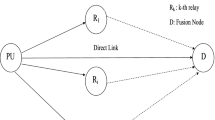Abstract
In this paper, we derive the detection probability of cooperative spectrum sensing with multihop relaying and Distributed Switch and Stay Combining (DSSC). The primary user signal is amplified by relay nodes using Amplify and Forward multihop relaying to reach the fusion node where spectrum sensing is performed. A given branch is used when its end-to-end Signal to Noise Ratio is larger than a predefined threshold T. Otherwise, the second branch will be activated. We show that the proposed sensing with DSSC offers similar performance as All Participating (AP) relaying where both branches are active. Besides, DSSC offers close performance to Selection Combining (SC) where the branch with largest SNR is activated. We also optimize threshold T to maximize the detection probability. Spectrum sensing with DSCC is less complex than SC since no signalization is required to select the best branch.










Similar content being viewed by others
References
Bryan G., Pourranjbar A., Kaddoum G: Collaborative Spectrum Sensing in Tactical Wireless Networks. IEEE International Conference on Communications (ICC), virtual conference, 7-11 June (2020)
Xiangyue M., Hazer I., Brian K.: End-to-End Deep Learning-Based Compressive Spectrum Sensing in Cognitive Radio Networks. IEEE International Conference on Communications (ICC), virtual conference, 7-11 June (2020)
Runze, W., Mou, W., Luokai, H., Haijun, W.: Energy-efficient cooperative spectrum sensing scheme based on spatial correlation for cognitive. Internet of Things, IEEE Access 8, 139501–139511 (2020)
Mehran, G., Fakharzadeh, M.: A fast soft decision algorithm for cooperative spectrum sensing. IEEE Trans. Circuits Syst. II Express Briefs 68(1), 241–245 (2021)
Dhaval, K.P., Brijesh, S.: Miguel López-Benítez?: Improved likelihood ratio statistic-based cooperative spectrum sensing for cognitive radio. IET Commun. 14(11), 1675–1686 (2020)
Digham, F.F., Alouini, M.S., Simon, M.K.: On the energy detection of unknown signals over fading channels. IEEE Trans. Commun. 55(1), 21–24 (2007)
Bhargavi D., Murthy C. R.: Performance Comparison of Energy, Matched-Filter and Cyclostationarity-Based Spectrum Sensing. SPAWC, Marrakech, Morocco, 20-23 June (2010)
Ghasemi A., Sousa E.: Collaborative spectrum sensing for opportunistic access in fading environments. in Proc. IEEE DySPAN, Baltimore, 8-11 Nov., pp. 131-136 (2005)
Visotsky E., Kuffner S., Peterson R. : On collaborative detection of tv transmissions in support of dynamic spectrum sharing. In: Proc. of IEEE DySPAN, 8-11 Nov., pp. 338-245, (2005)
Unnikrishnan, J., Veeravalli, V.V.: Cooperative sensing for primary detection in cognitive radio. IEEE J. Select. Topics Signal Process. 2(1), 18–27 (2008)
Caso G., , De Nardis L., Ferrante G. C., Di Benedetto M. G.: Cooperative spectrum sensing based on majority decision under CFAR and CDR constraints. PIMRC, London, 8-11 Sept. (2013)
Atapattu, S., Tellambura, C., Jiang, H.: Relay Based Cooperative Spectrum Sensing in Cognitive Radio Networks. GLOBECOM, Honolulu, (2009)
Atapattu, S., Tellambura, C., Jiang, H.: Energy detection based cooperative spectrum sensing in cognitive radio networks. IEEE Trans. Wireless Comm. 4(10), 1232–1241 (2011)
Alhamad, R., Boujemaa, H.: Multihop multibranch spectrum sensing for cognitive radio networks. Arab. J. Sci. Eng. 44(8), 6711–6726 (2019)
Tsang-Yi, W., Feng-Tsun, C., Chi-Kai, H.: Collaborative Sampling and Binary Local Output Generation for Distributed Blind Cooperative Spectrum Sensing. IEEE Trans. Commun., Early access (2021)
Vivek, G., Shivendra, N.S., Narendra, S.B., Sunil, K.C.: Cooperative Fusion rules in Spectrum Sensing. Presented at the (2021)
Anastassia, G., Ejaz, W., Ibnkahla, M.: Distributed Spectrum Sensing for IoT Networks: Architecture, Challenges, and Learning. IEEE Internet of Things Magazine, Early Access Article (2021)
Phuong, T.T., Ohishi, K., Yokokura, Y.: Deep Learning Based Singular Spectrum Analysis for Realization of Wideband Force Sensing. Presented at the (2021)
Liu R., Ma Y., Zhang X. , Gao Y. : Deep learning-based spectrum sensing in space-air-ground integrated networks. J. Commun. Inf. Netw., Volume: 6, Issue: 1, (2021)
Nimudomsuk, P., Sanguanwattanaraks, M., Srisomboon, K., Lee, W.: A Performance Comparison Of Spectrum Sensing Exploiting Machine Learning Algorithms: 18th International Conference on Electrical Engineering/Electronics. Computer, Telecommunications and Information Technology (ECTI-CON) (2021)
Gattoua C., Chakkor O., Aytouna F.: “An overview of Cooperative Spectrum Sensing based on Machine Learning Techniques”. In: 2020 IEEE 2nd International Conference on Electronics, Control, Optimization and Computer Science (ICECOCS)
Giri M. K., Majumder S., “Extreme Learning Machine Based Cooperative Spectrum Sensing in Cognitive Radio Networks”. In: 7th International Conference on Signal Processing and Integrated Networks (SPIN) (2020)
Zhenjiang, S., Wei, G., Shangwei, Z., Jiajia, L., Nei, K.: Machine learning-enabled cooperative spectrum sensing for non-orthogonal multiple access. IEEE Trans. Wireless Commun. 19(9), 5692–5702 (2020)
Michalopoulos, D.S., Karagiannidis, G.K.: Two-relay distributed switch and stay combining. IEEE Trans. Commun. 56(11), 1790–1794 (2008)
Michalopoulos, D.S., Karagiannidis, G.K.: Distributed switch and stay combining (DSSC) with a single decode and forward relay. IEEE Commun. Lett. 11(5), 408–410 (2007)
Hasna, M.O., Alouini, M.S.: Outage probability of multihop transmission over Nakagami fading channels. IEEE Commun. Lett. 7(5), 216–218 (2003)
Nuttall A.H.: Some integrals involving the QM function. Naval Underwater systems Center (NUSC), technical report, May (1974)
Author information
Authors and Affiliations
Corresponding author
Additional information
Publisher's Note
Springer Nature remains neutral with regard to jurisdictional claims in published maps and institutional affiliations.
Appendix A
Appendix A
When there are two branches without a direct link, we have:
When there is a direct link, the derivative of detection probability is expressed similarly to (33).
Rights and permissions
About this article
Cite this article
Alnwaimi, G. Spectrum sensing with multihop distributed switch and stay combining. SIViP 16, 515–522 (2022). https://doi.org/10.1007/s11760-021-01994-3
Received:
Revised:
Accepted:
Published:
Issue Date:
DOI: https://doi.org/10.1007/s11760-021-01994-3




